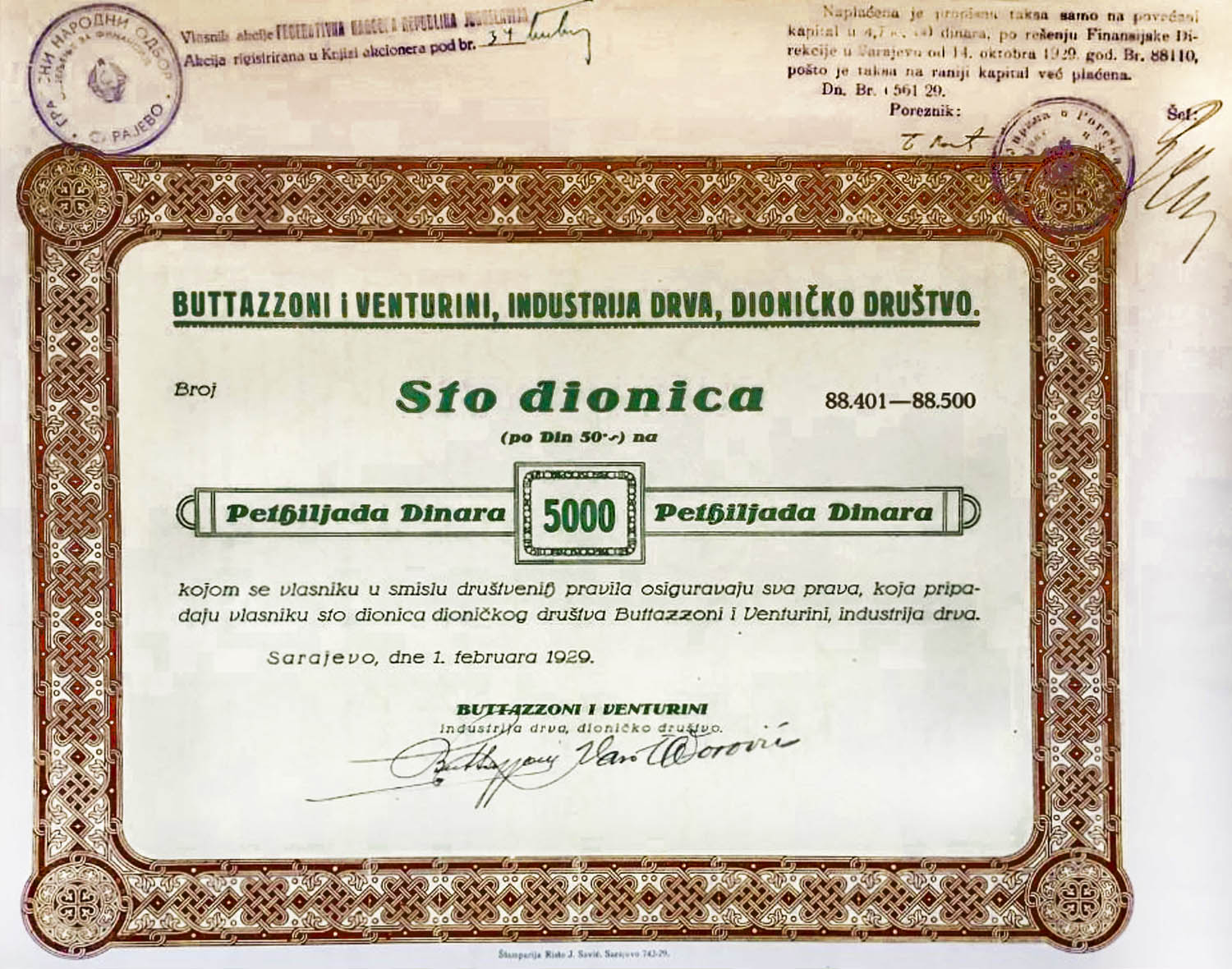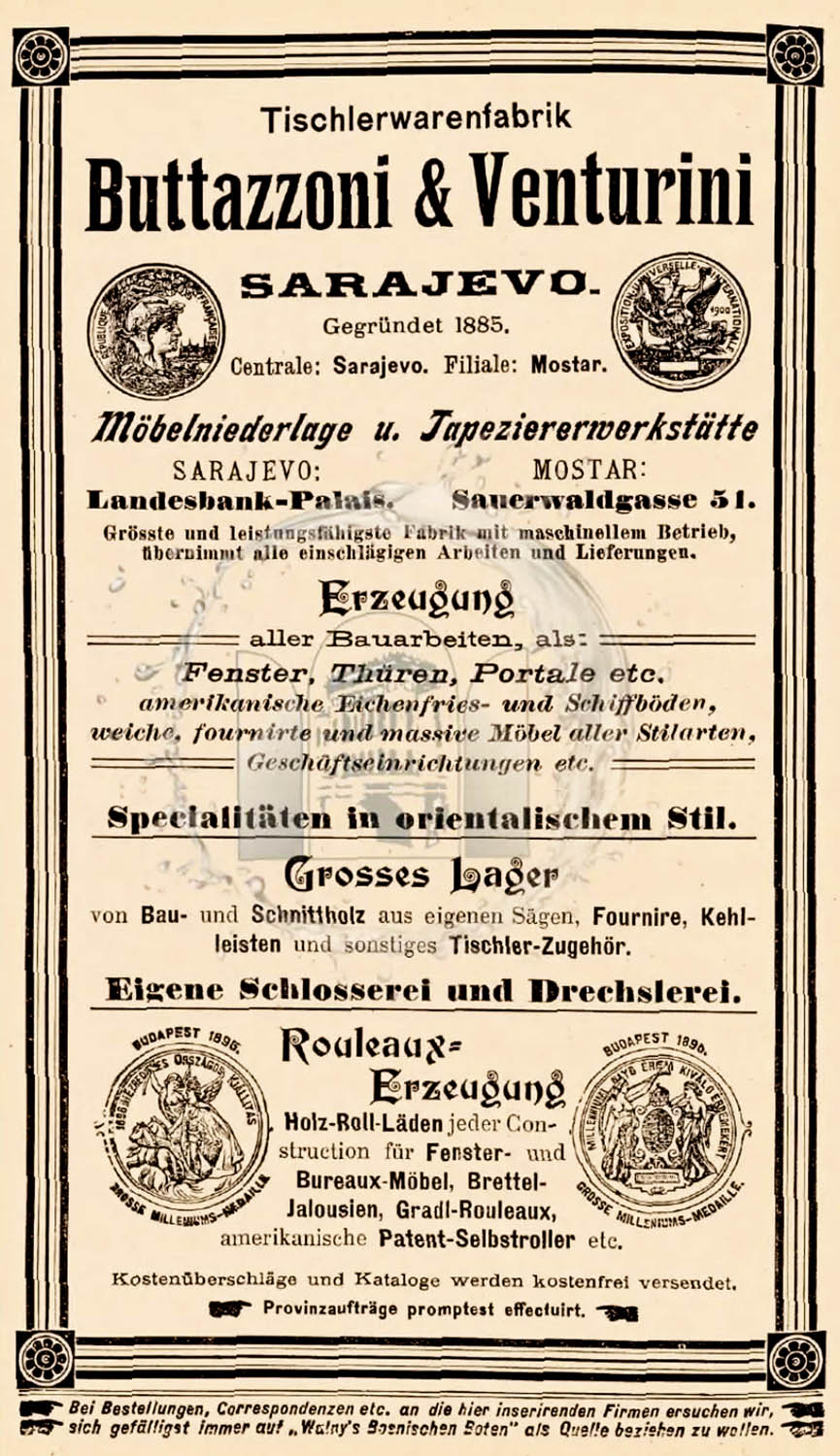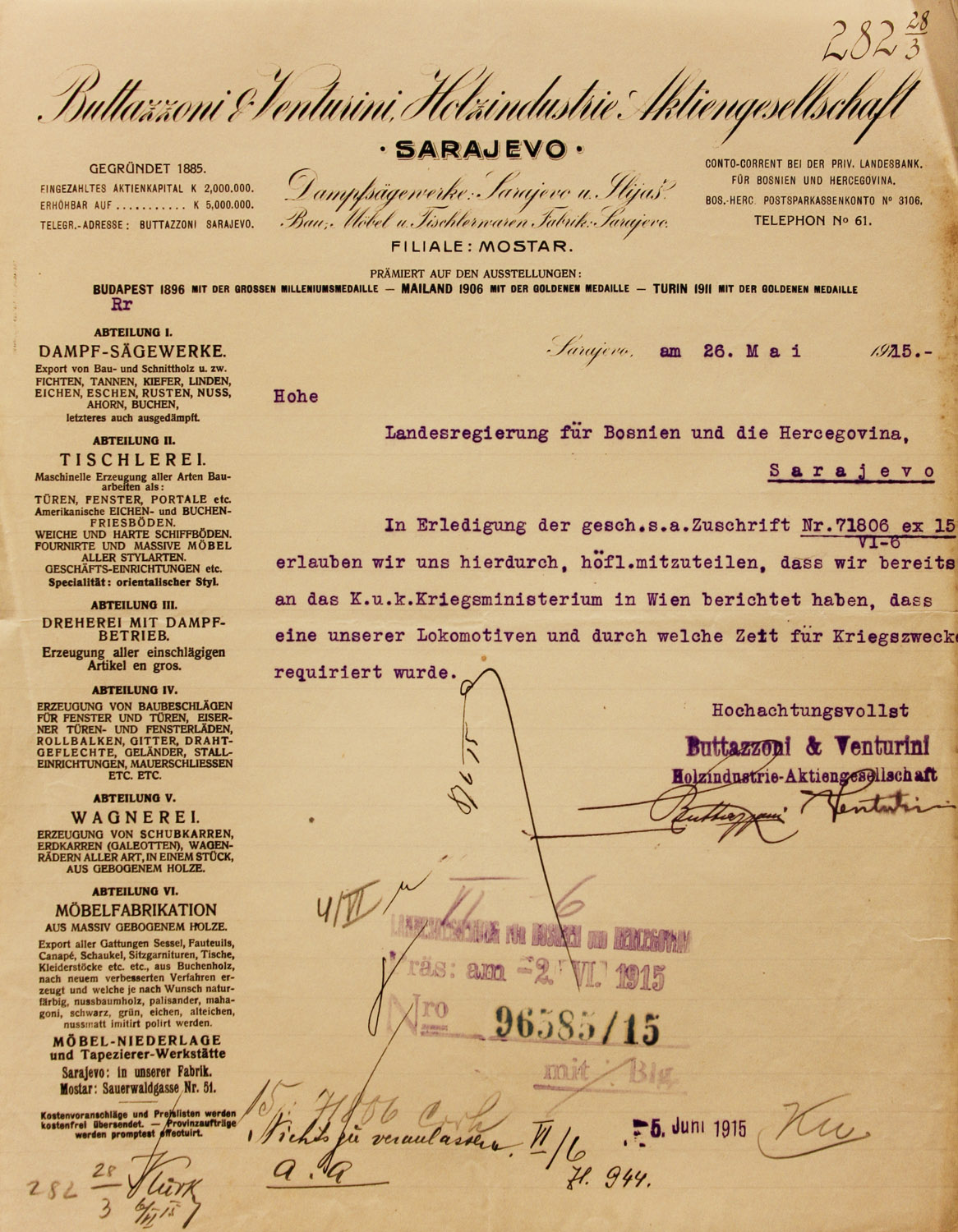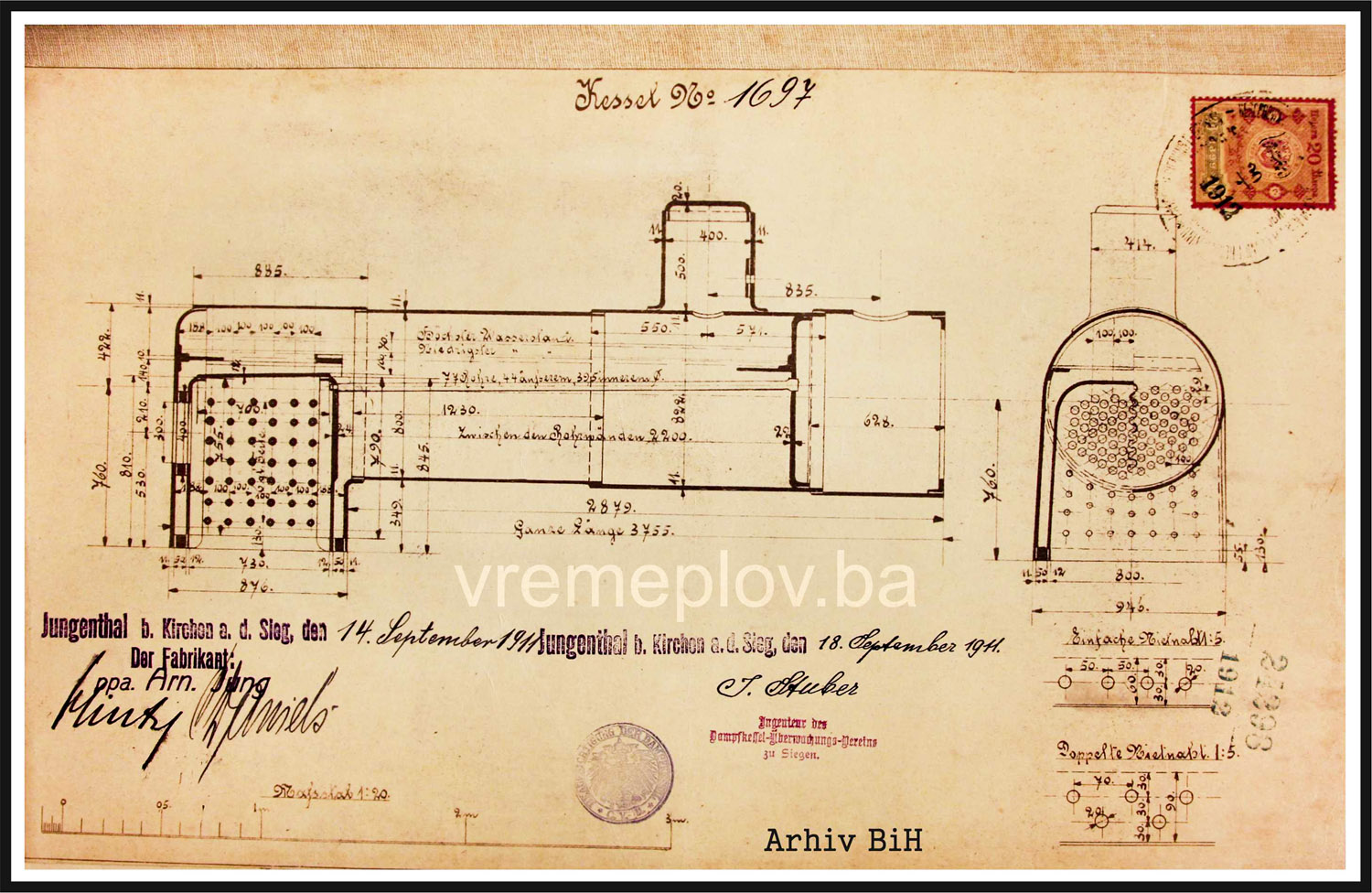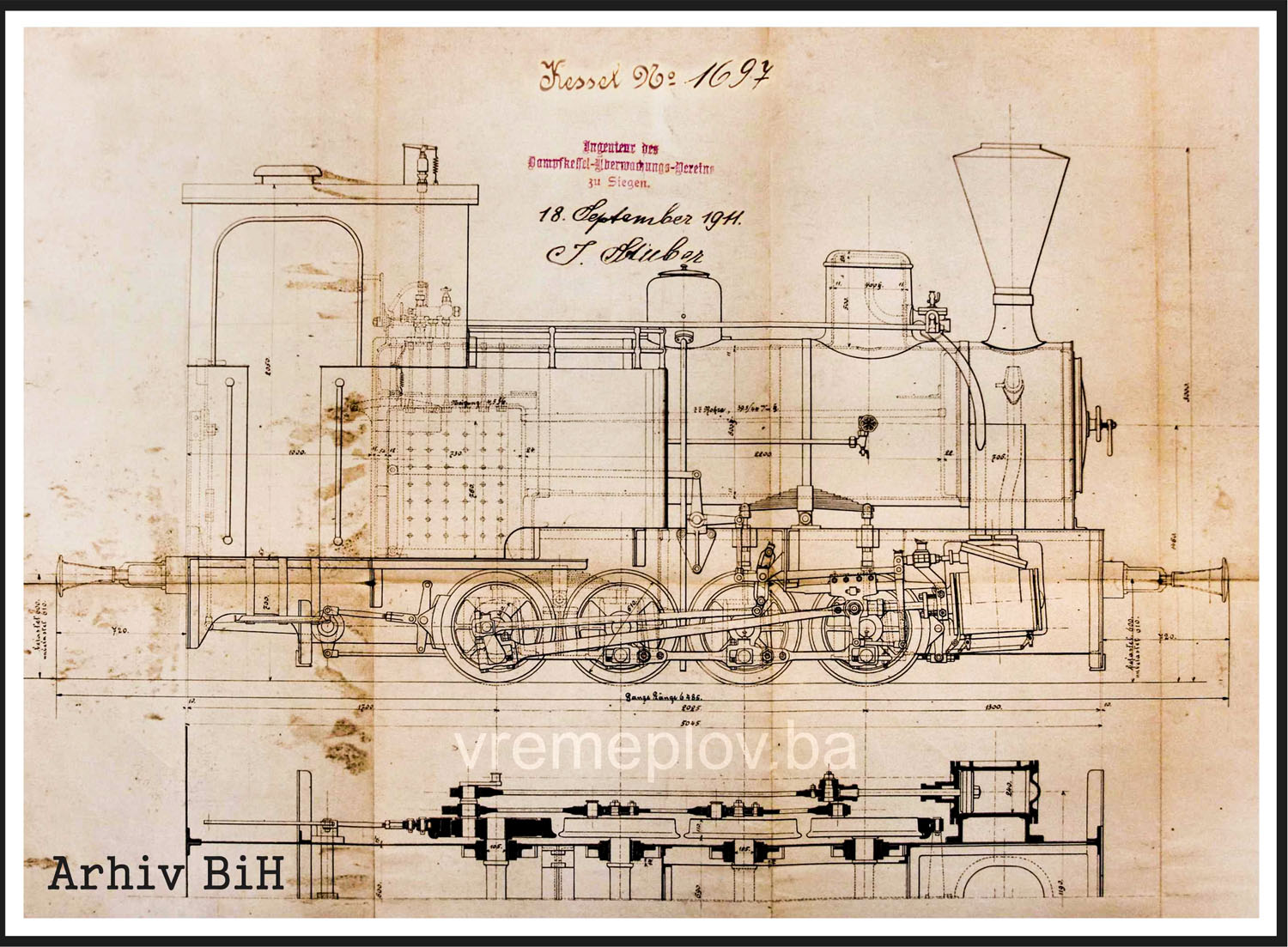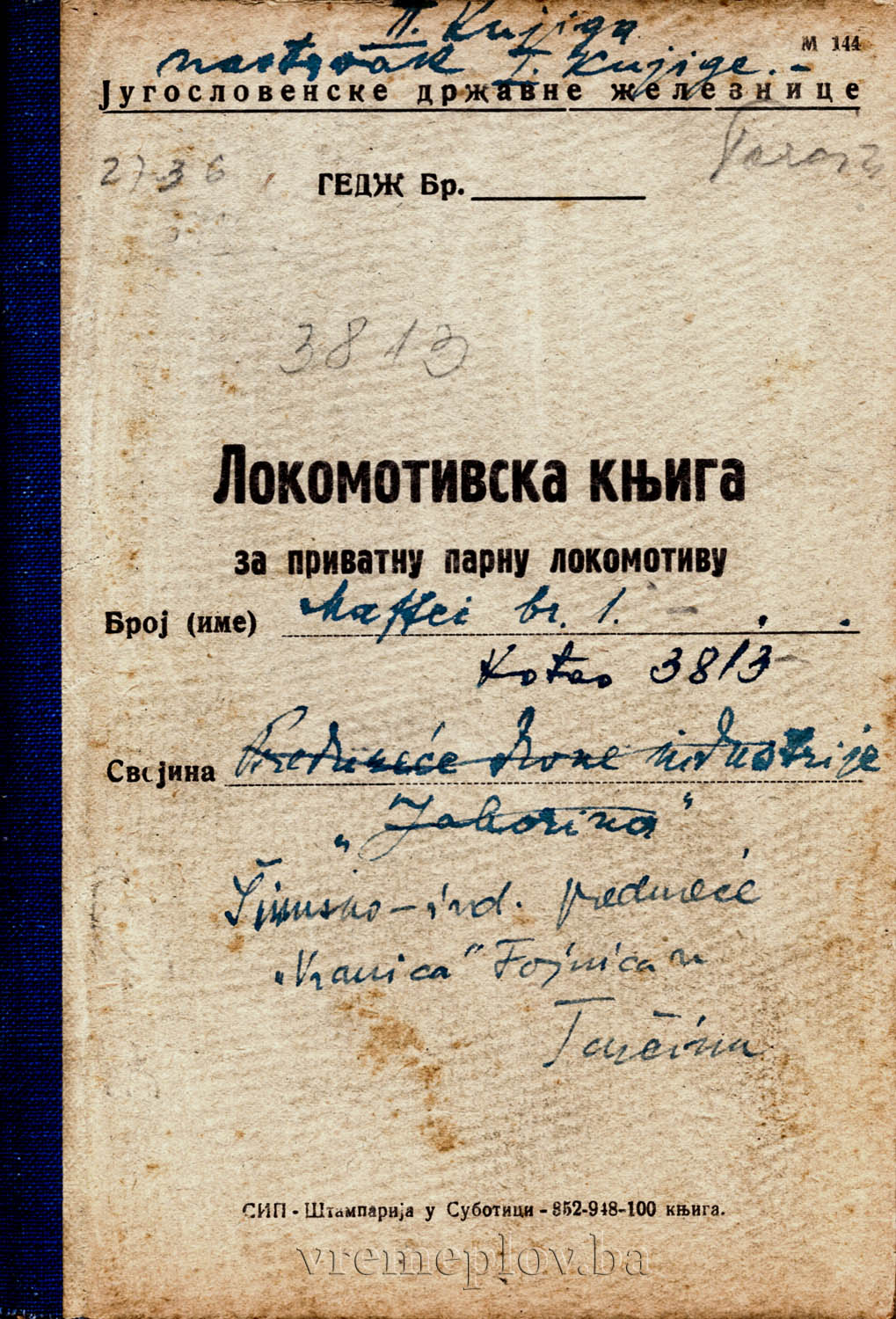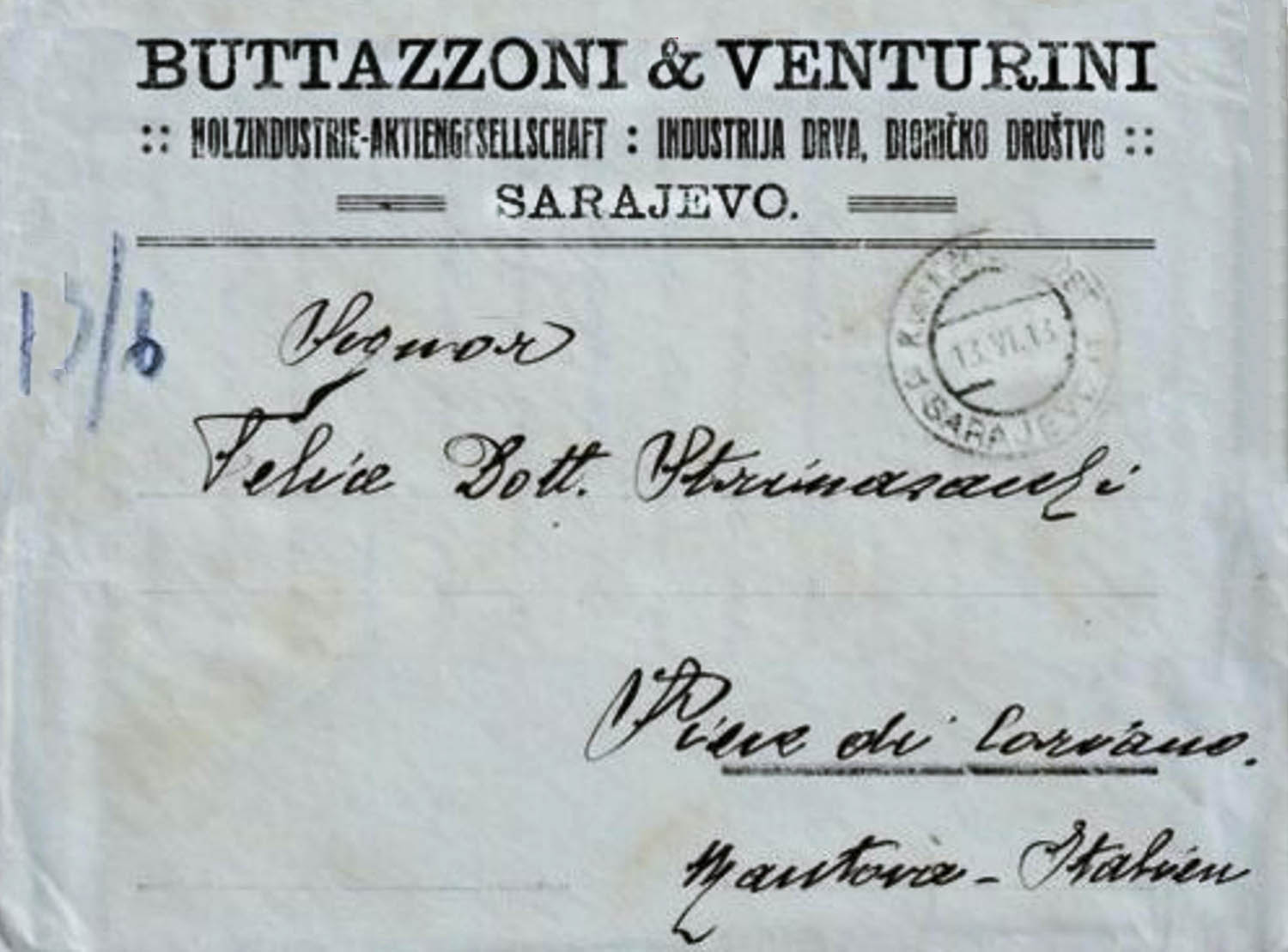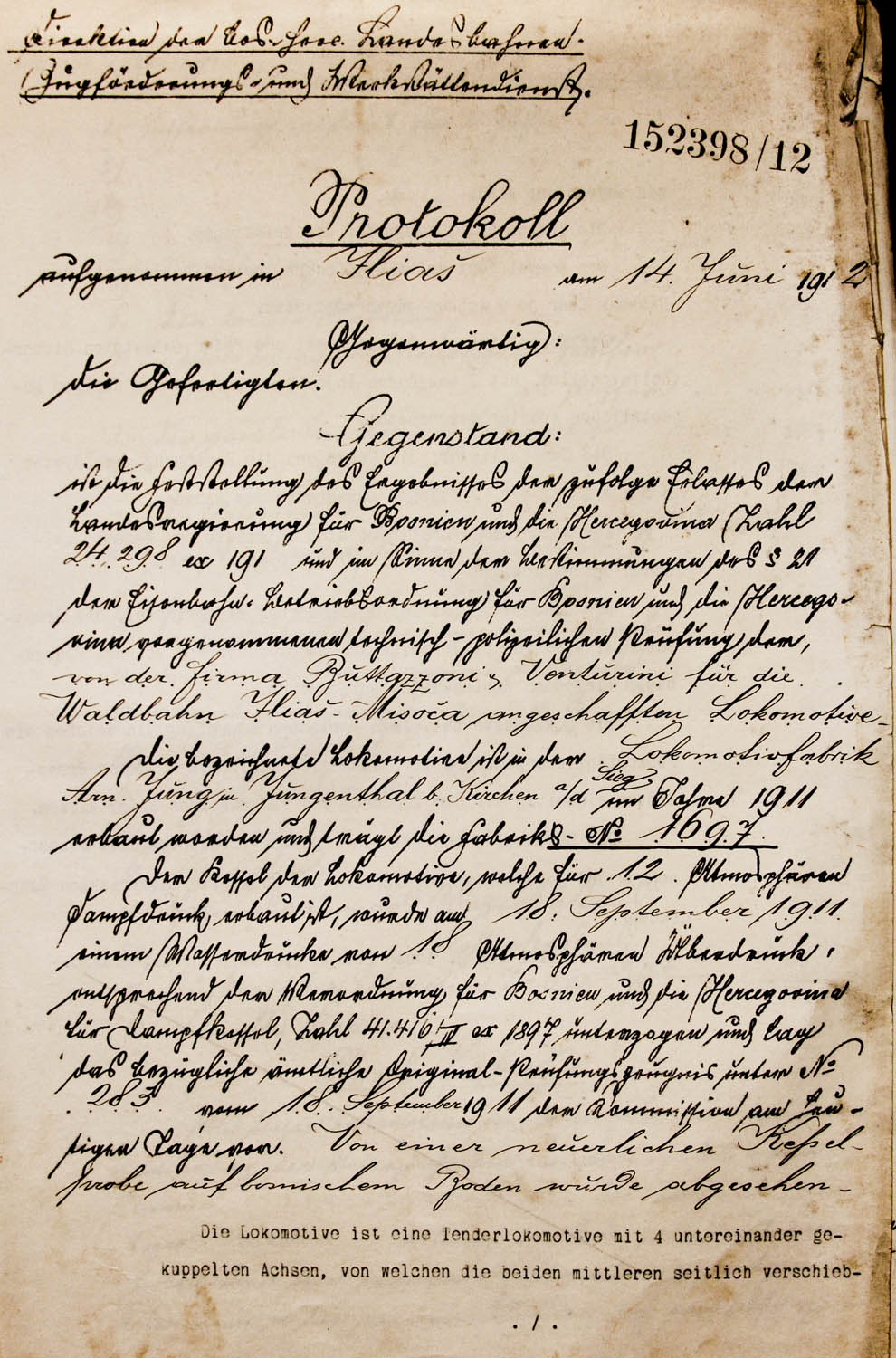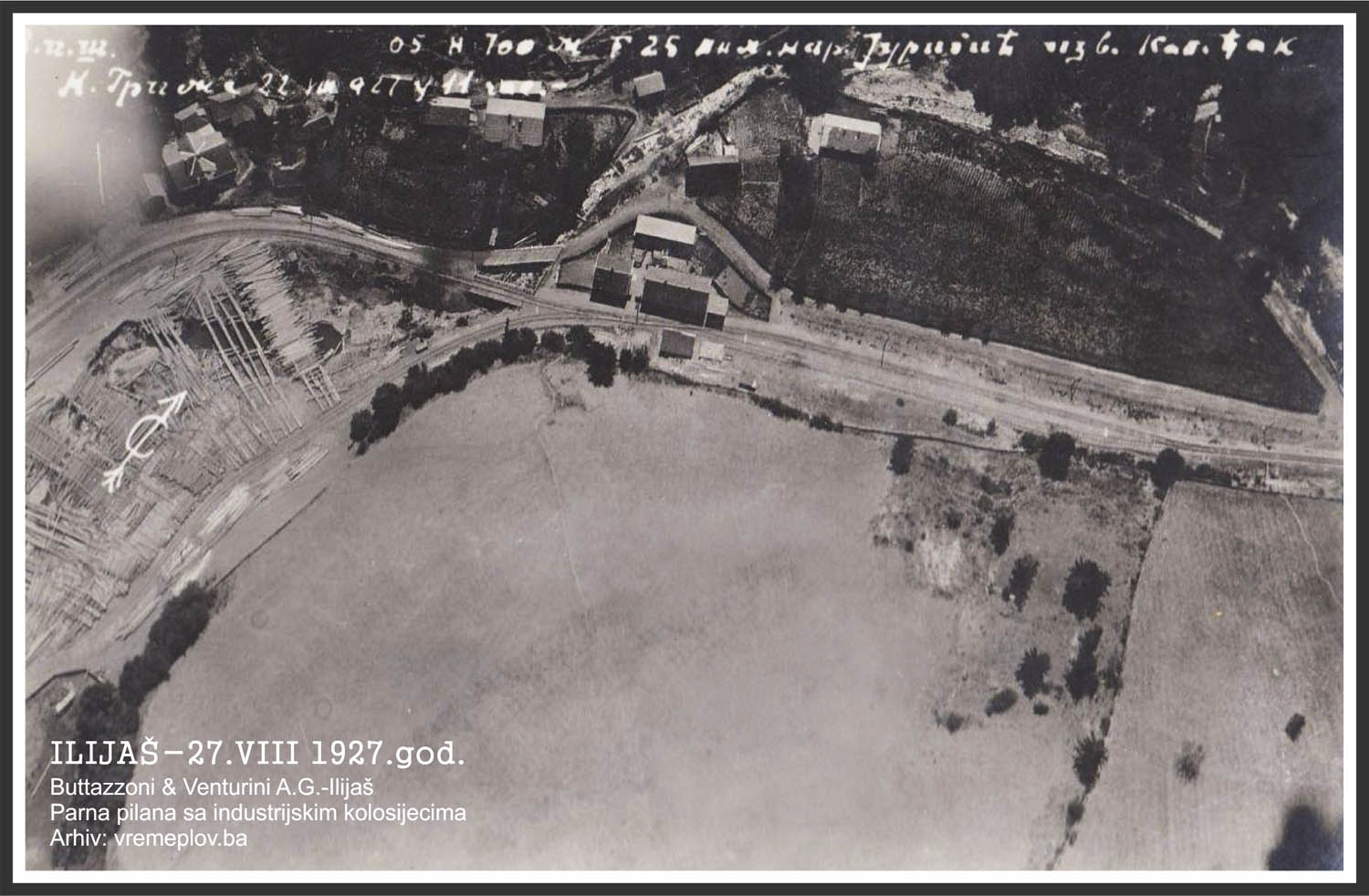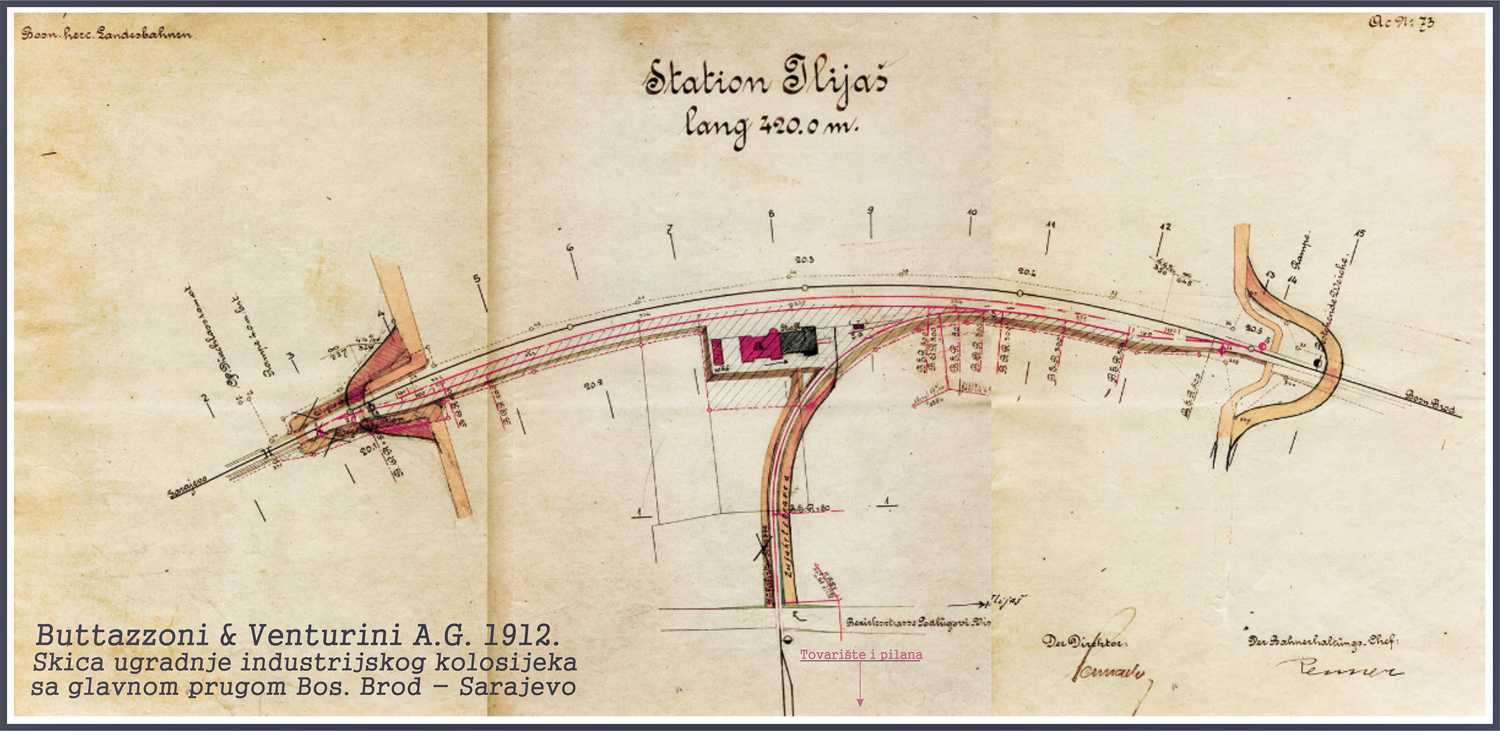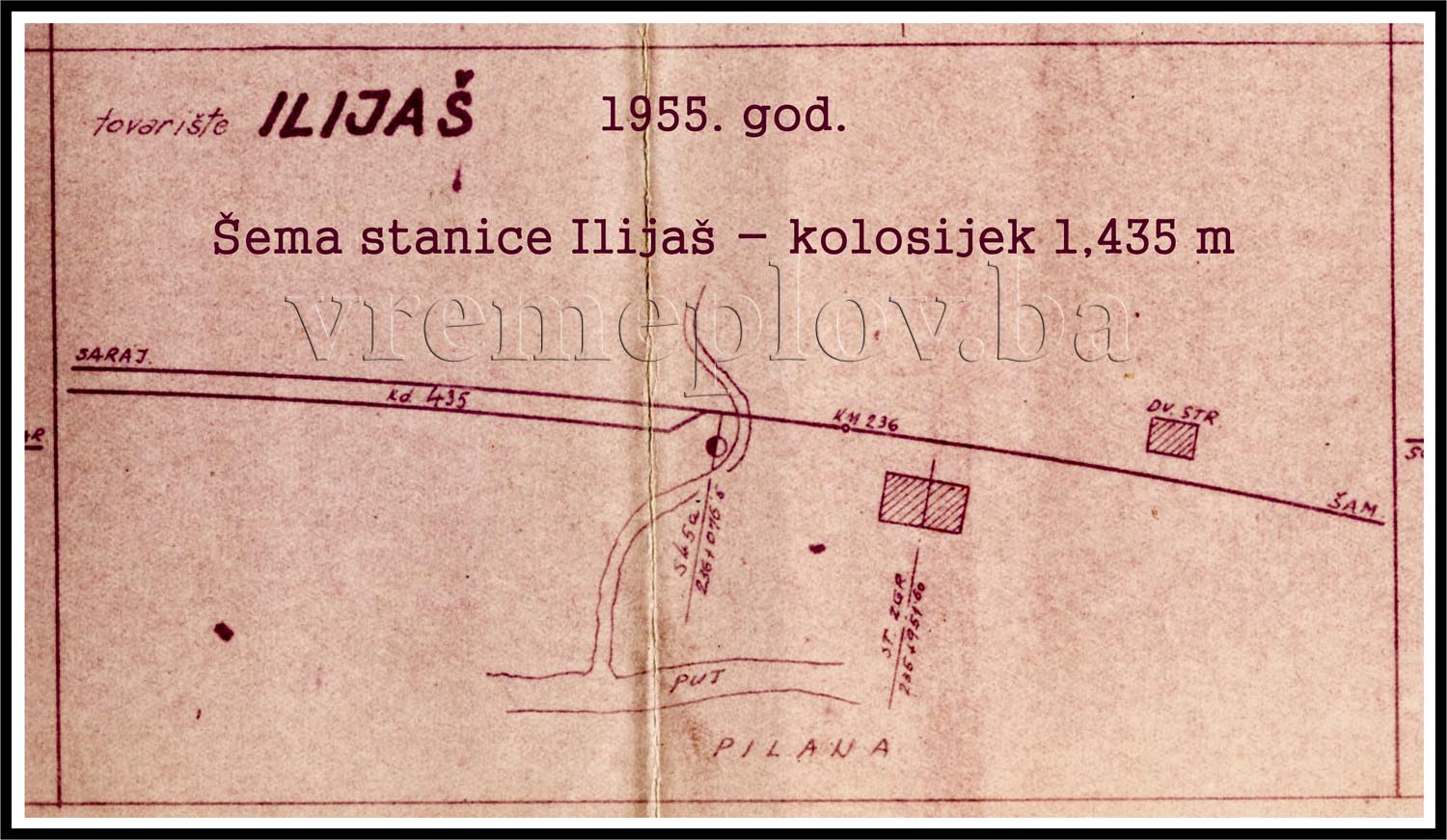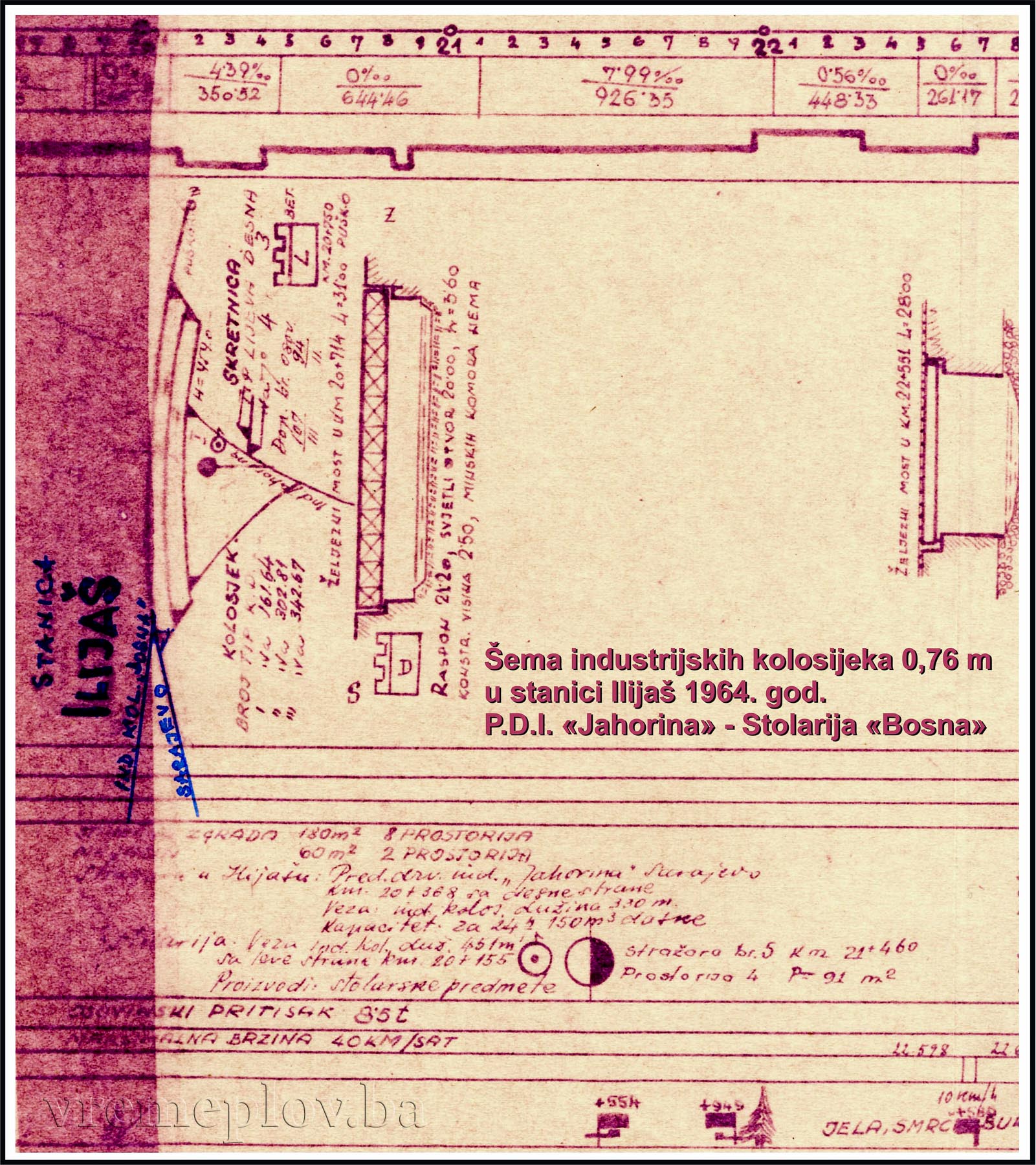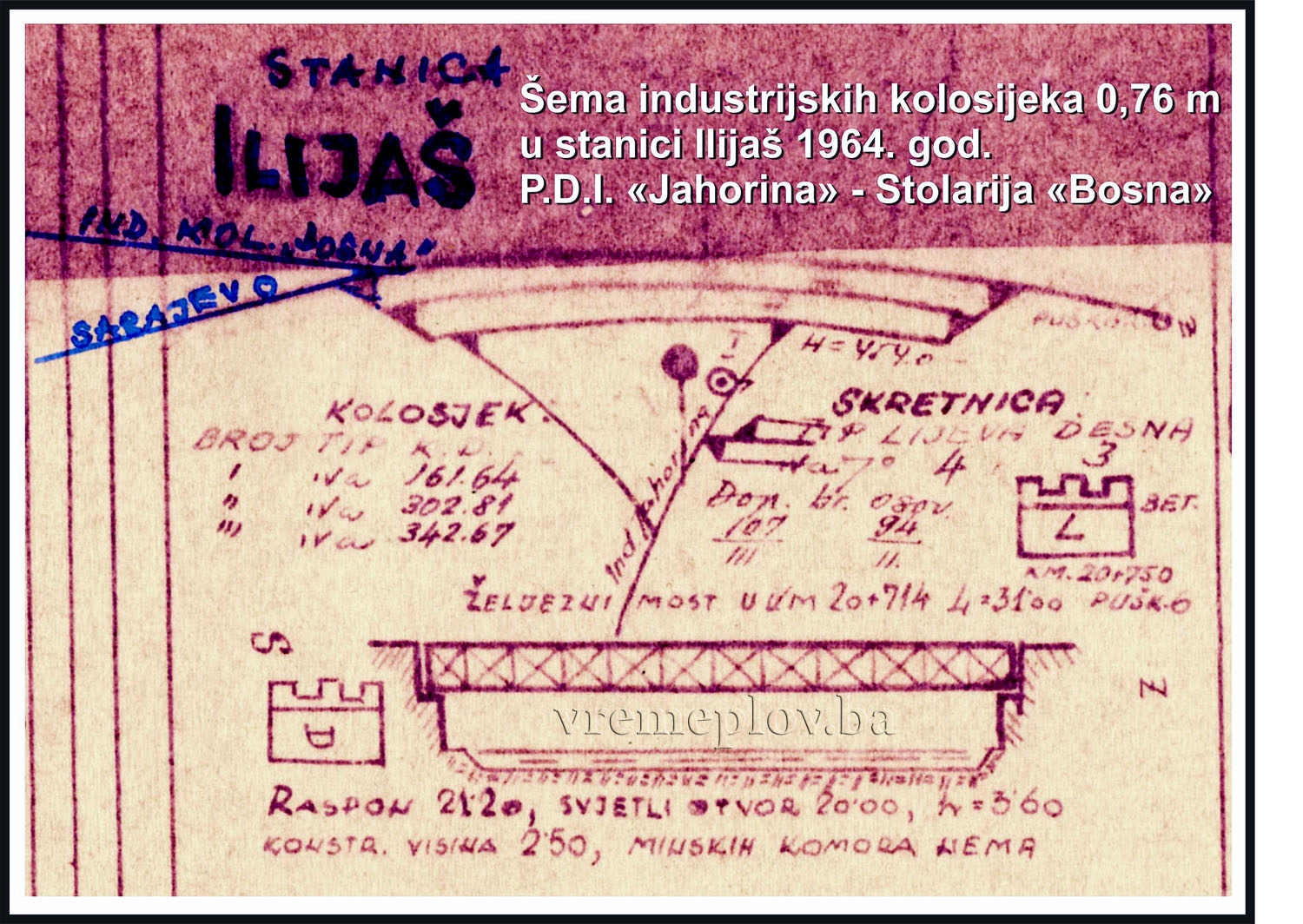Written by: Srećko Ignjatović
This work and the text in the first part represent an attempt and serve the purpose of presenting a more accurate and faithful picture of the industrialization of the town of Ilijaš, covering the period from the Austro-Hungarian administration (1878-1918), the Kingdom of SHS/Yugoslavia (1919-1941), and the Socialist Federal Republic of Yugoslavia (1945-1992), with a particular emphasis on the development and exploitation of forests in the Misoča river valley.

In approaching this quite complex matter correctly and aiming to achieve relevant results, based on original materials and acceptable original information, we will look through examples of the rise of two companies: “F. Steinmetz & Co.” (1886-1917) and “Buttazzoni & Venturini” (1890-1945), both from Sarajevo.
The primary literature for this work includes books:
- Branislav Begović, 1978. „Razvojni put šumske privrede u Bosni i Hercegovini u periodu austrougarske uprave (1878—1918) sa posebnim osvrtom na eksploataciju šuma i industrijsku preradu drveta“,
- Branislav Begović, 1985 „Šumska privreda Bosne i Hercegovine za vrijeme monarhističke Jugoslavije (1918.-1941.) s posebnim osvrtom na eksploataciju šuma i industrijsku preradu drveta. Sarajevo“,
- Dževad Juzbašić, 1974. „Izgradnja željeznica u Bosni i Hercegovini u svjetlu austrougarske politike od okupacije do kraja Kállayeve ere“i
- Web portal vremeplov.ba, Lični arhivski fond.
By occupying Bosnia and Herzegovina in 1878, Austria-Hungary gained possession of significant natural resources, among which were forests. In order to secure the necessary financial revenues for the state treasury, the Austro-Hungarian administration in Bosnia and Herzegovina initially focused on selling individual forest areas through direct agreements and long-term contracts with certain companies and entrepreneurs.
Based on free agreements, long-term contracts for forest exploitation were concluded in two forms: exploitation of oak and beech forests with manufacturing production, and exploitation of forests within the framework of erars forest management operations (B. Begović, 1978).

One such agreement (with manufacturing production) was concluded with the private company “F. Steinmetz & Co.” in 1886, and within the framework of Erar’s forest management operations with the company “Buttazzoni & Venturini” in 1898. Before we proceed to the main topic, allow us to briefly outline the business biography of the company “F. Steinmetz & Co.”.
The company “F. Steinmetz & Co.”
Franz Steinmetz (senior) and Franjo Steinmetz (junior) migrated from Austria to Sarajevo in 1886. In the same year, they registered a company called “F. Steinmetz & Co.” at the Sarajevo municipal court, with the declared activity “Trading in wood for construction and fuel.” The company’s headquarters and residence address were registered on Čemaluša Street, and the wood storage (Holzplatz) in Kolodvorska Street (Bahnhofstraße) within the Ferhadija city settlement. (Source: Bosanski Glasnik, 1902).
Most of the necessary timber was supplied from their own sawmill, with a smaller part obtained through auction or direct contracts with owners of other enterprises.
Company “F. Steinmetz & Co.” – Mošćanica Sawmill near Vasin Hana, Sarajevo
In 1886, the company built a water-powered sawmill on the Mošćanica River near Vasin Hana. This was also the first sawmill built on the Mošćanica River. The sawmill was designed to operate on water power and was very primitive, essentially functioning as a ‘stream’ sawmill in the full sense. Namely, water was diverted through a special ‘jazz’ (trough) to the sawmill, falling through a wooden ‘badanj’ (a barrel without a bottom) onto a small wooden wheel that turned around a horizontally placed wooden axle. Attached to this wooden axle was the so-called ‘gega’ (synonym – jumps, climbs, moves), made of wood and consisting of a shaft with a set and long poles, which raised and lowered the frame of the ‘harness’ (frame) on which a Venetian blind gear was mounted, that is, a steel saw about 0.5 cm thick.
The annual capacity of this sawmill could not exceed more than 100 m³ of softwood timber. The sawmill timber was procured through auctions from the Vučja Luka region, that is, from the Kalina – Bioštica forest area. Due to the difficult transportation of forest timber to the sawmill and the high cost of transporting cut lumber to the warehouse in the city, the company decided to sell the sawmill.
Nezir Hadžija purchased the Nevedenu sawmill, and Ismet Šljaka bought it from him, who transferred the sawmill (1918) to steam power.
The last owner was Nedeljko Stokić (born in 1933), who installed a full gate with an installed steam engine of 55 HP in that sawmill, in addition to a Venetian blind. (B. Begović 1978. ABH FDŠS – Household Register of Small Local Sawmills, Folio 60-61).
The Enterprise “F. Steinmetz & Co.” – Sawmill in Srednji near Sarajevo
Towards the very end of the nineteenth century, the company built its first water-powered sawmill near the Rač stream (a left tributary of the Ljubina river) at Srednje. During the construction of the sawmill, a Venetian gate was installed and put into operation.
Later, with the signing of the forest exploitation contract with the State Government (1901), a second gate was also installed.
The necessary logging for the company was supplied from the forest area of Rača – Kalina (Laza and Lipnik forests) with an annual capacity of about 2,400 m³ of processed coniferous wood. The logs were transported to the sawmill using water wooden ‘riža’ (Wässriger Holzreis), and the sawmill products were transported by forest-mining narrow-gauge railway to Semizovac, or to Sarajevo, to the lumber storage in Ferhadija. The sawmill operated until the end of 1917, when it was sold, at which point it was bought by Danilo Ćorović from Sarajevo.

In 1922, near the mouth of the Raca stream into the Ljubina river, Luka Čabrajić will build a steam-powered sawmill, and in March 1926, he registers it with the company “Ozren” – Forest Industry Ltd. Central. One of the shareholders was Danilo Ćorović, who contributed his water-powered sawmill to the newly established company, which he had previously purchased from Franz Steinmetz. (B. Begović 1985.)

Company “F. Steinmetz & Co.” – Tarčin near Sarajevo
In 1901, the company “F. Steinmetz & Co.” will sign a long-term contract with the National Government for the exploitation of the Preslica forest area – Lapov Dol – Lanište near Tarčin. The subject of the contract was the logging of about 80,000 m³ of coniferous and 50,000 m³ of beech usable timber, along with the by-products of firewood.
Due to financial difficulties, the company was unable to proceed with the implementation of the concluded contract. This situation lasted for about two years, during which the State Government issued a warning to the company with a justification for terminating the contract if immediate action on exploitation was not taken; otherwise, it would lose its concession rights, as stipulated in the relevant contract.
In the newly arisen situation, the company enters into ‘business’ negotiations with the newly established firm “Rafael Z. Finci & Co.” (founded in 1902, with co-owners Ellas Baruh and Isak Baruh), which in 1903 will ‘buy out’ and transfer to itself the contract from 1901 regarding the long-term exploitation of the contracted forest area that was once owned by the company “F. Steinmetz & Co.” The company will soon build a forest railway line combining adhesion (10.6 km) and gravitational (5.4 km) railway tracks (cogwheel railway) with a length of approximately 16.0 km, running from Tarčina through Guvništa to Lanište and Lapov Dola. Simultaneously, the company erected in Tarčin a steam sawmill powered by a 200 HP engine, equipped with four gater machines along with all other machinery and devices.
In 1911, the company “Rafael Z. Finci and Co.” will be transformed into a joint-stock company called The Shareholders’ Company for the Exploitation and Export of Wood “Jela,” which continued to implement the contract from 1903. (B. Begović 1978.)
From this brief fragmentary overview of the operations of the company “F. Steinmetz & Co.,” it can be concluded that the company had very limited capital.
Although the contractual area and the location of Tarčin relied on the state railway Sarajevo – Metković (built in 1891), establishing a sawmill and constructing a railway line for this company was a huge investment project that they could not realize. Interestingly, a similar business mistake happened to the company in 1910.
Certainly! Here’s your translated section: Namely, the State Government for Bosnia and Herzegovina and the company “F. Steinmetz & Co.” will sign a long-term contract for the exploitation of the Misoča forest area near Ilijaš, lasting 15 years. Since the company did not proceed with the implementation of the signed contract after two years, the state treasury will initiate a legal dispute in the competent court in Sarajevo. As a result of the settlement regarding the legal dispute, the company, now operating as “Inokosno Company F. Steinmetz,” will merge (form a business alliance) with the company “Buttazzoni and Venturini.” (Source: Branislav Begović, 1978.)
The company “Buttazzoni and Venturini,” observing the Sarajevo district and beyond, was one of the strongest and most successful economic entities in the wood-processing industry. Below, we will briefly outline the biography of the operations of this mentioned company.
“Buttazzoni and Venturini” – Arrival in Sarajevo and Business Registration
In 1885, Peter Buttazzoni, a carpenter by profession, and Ivan Venturini, a carpenter and machinist from Italy, migrated to Sarajevo and registered the company “Buttazzoni and Venturini,” with an initial capital of two million crowns, with a clause that each shareholder signs for themselves. The primary activity was the production of building carpentry and furniture, as well as exporting goods abroad. With this starting capital, they built a steam sawmill in Sarajevo (near Koševski Stream) and a carpentry factory (“Tischler Warenfabrik”) with a warehouse for sawed timber (“Holzplatz”) and firewood. The address registered for residence, along with the factory, is in Kolodvorska Street (“Bahnhofstraße”) in the municipal area of Ferhadija. (Source: Bosanski Glasnik, 1902).
“Buttazzoni i Venturini” – construction of a sawmill in Sarajevo and expansion of activities
In 1898, the company will construct a steam sawmill (Sägewerk) in the ‘settlement’ of Koševo along the Koševo Stream, as well as a factory for building carpentry and furniture, employing 120 workers.
The industrial plant consisted of: a steam engine with a power of 50 HP, two gaters, four circular saws, twenty installed woodworking machines (bandsaw, planers, routers, thicknessers, grinders, veneer peeling machine, presses, etc.). The machines were predominantly operated by foreign workers with work experience, while local workers performed lower-skilled tasks (assistants in machine operation) and heavier physical labor. (Dževad Juzbašić, 1974.)

In 1890, instead of the name Carpentry Goods Factory (Tischler Warenfabrik), it was renamed Furniture Factory (Möbelfabrik). The product range includes: windows, doors, portals, retail equipment, ship floors, square solid furniture of all styles, oak friezes, veneers, crown moldings, and a variety of other carpentry accessories and special furniture in an oriental style.
Thanks to the visionary educational support of the then regime, generations of artisans in woodcarving were educated, and their techniques were perfected to the point of unrecognizability. Many of the graduating artisans found employment with the well-established furniture manufacturer “Buttazzoni i Venturini” in Sarajevo and Mostar. Namely, the company opened a branch in Mostar in 1886 and built a smaller furniture factory (workshop), registered in 1891, employing up to 35 workers. Hand-carved furniture pieces from the Mostar factory (peškuni, chairs, sofas, etc.) were exhibited at fairs and exhibitions in Budapest in 1896, Paris – the Millennium Exhibition in 1900, Milan in 1906, winning a gold medal, Turin in 1911, gold medal, etc. (Source: Bosanski Glasnik 1915.)

It is worth mentioning one of the pioneers of woodcarving-entrepreneurs at the beginning of the twentieth century, Gano Nikšić from Konjic. He learned the technique of carving (flower-shaped borders and other shapes) from already trained craftsmen, later developed and perfected this technique, and then passed it on to his son. He established a ‘company’ in Konjic in 1927, which still exists today. Additionally, Konjic woodcarving was inscribed on UNESCO’s list of intangible cultural heritage of humanity in November 2017.
“Buttazzoni and Venturini” – Forest exploitation in the forested area of the Povača stream basin
For continuous operation, the constructed sawmill in Sarajevo (Kosevski Stream) was supplied with the necessary sawn timber from the erarski management operations of the Forest Administration Sarajevo, from the contractual forest area in the Povača stream basin.
In 1898, through a free agreement, the company “Buttazzoni and Venturini” signed a long-term contract with the Government of Bosnia and Herzegovina for the exploitation of 40,000 – 60,000 m³ of coniferous timber in the forests located in the gravitational basin of the Povača stream, a right tributary of the Ljubina River. These forests were also designated and reserved for utilization under the management of the forest administration in Sarajevo.

This year, at the confluence of the Povača stream into the Ljubina river, the company will build a water-powered sawmill with one installed Venetian gate. Part of the timber mill’s lumber was processed in this sawmill, and the remaining processed lumber was transported by rail (Ljubina – Semizovac – Sarajevo) to the storage yard of the steam sawmill in Sarajevo.
After the ten-year period (1908), the company was granted an additional 30,000 m³ of coniferous useful wood from the same contractual area through a subsequent agreement, for a duration of three years (until 1911). During the term of the contract (1898-1911), the company harvested approximately 80,000 m³ of coniferous wood, which through processing yielded about 35,000 m³ of sawn timber.
Most of the sawn timber was used in its own furniture factory, while a smaller portion was subject to export abroad. (Dževad Juzbašić, 1974.)
The Construction of the Company’s Forest Road “Ljubina – Povača”
For the transportation of cut forest timber to the sawmill, the company built a gravity track (cog wheel railway) with a length of 7.3 km, consisting of 7.2 km of the ‘main’ track and 0.10 km of branch track, under the working name “Ljubina – Povača.” This branch track led from the sawmill to the junction with the mine railway Vogošća – Čevljanović (which was put into service on January 26, 1885). This railway was owned by the mining cooperative “Bosnia” (Gewerkschaft Bosnia) until mid-1896, when it was purchased in favor of the state treasury.

From this junction, the line continued along a state railway approximately 1500 meters to the Ljubina railway station. From Ljubina station, the train compositions were dispatched to Semizovac station, about 9.5 km away, where it connected with the ‘mainline’ railway Bosanski Brod – Sarajevo (which was opened for traffic in 1882).
The cutting mass for the sawmill was transported using twenty “truck” wagons, with strong axles of 70 mm in diameter, capable of carrying around 7 tons of cargo. The value of the investment was approximately 60,000 crowns. (Source: Forest Railways of Bosnia and Herzegovina 1911. Reported by: Gyula Sztehlo, Chief Engineer of the Forest Department of the Royal Government of Bosnia and Herzegovina. pp. 1002-1016).

The purpose of presenting the above data is to finally clarify the longstanding mystery surrounding the name of the gravity rail line “Ljubina – Povača.”
Namely, during the drafting of the rail construction protocol (manuscript, 1898), an official person illegibly wrote the data “Porača,” and during the protocol registration at the competent ministry, another person writes “Prača” on the cover of the main file. The handwritten text (with the name Ljubin – Prača) is sent to the Ministry of Public Finances for review and approval.
When printing the booklet “Report on the Administration of Bosnia and Herzegovina 1914-1916” (Bericht über Verwaltung von Bosnien und Herzegowina 1914-16), the responsible editor enters the data “Ljubina – Prača.” Later, this information will be adopted and listed in many book editions, which will cause significant confusion for researchers and will attribute the mentioned “gravitational railway” to the forest railway “Ilijaš – Misoča – Okruglica.”
Allow us to move on to the main topic of this interesting story.
“Buttazzoni and Venturini” – Integration with the company “F. Steinmetz & Co.”
As already mentioned above in the text, the first interest in the exploitation of the forest area in the Misoča river basin was shown by the company “F. Steinmetz & Co.” In 1910, the company signed a fifteen-year contract with the Provincial Government for the exploitation of the specified forest area. After two years, due to passivity in the realization of the contracted forest area exploitation, the signed contract became the subject of a court dispute.
Based on the lawsuit claim, the company defended itself by stating that the failure was a consequence of a lack of financial resources and that it had been unable to obtain the necessary loan. The prosecution proposes that the Court Panel annul the relevant contract on the grounds that the company is incapable of further executing the contract and that it deliberately entered into the purchase based on speculative motives, with the intention that through resale and transfer of the contract and contractual areas, they could easily make a profit.

How the company “Buttazzoni and Venturini” was left without the necessary forest raw materials (executing a thirteen-year exploitation of the forest area in the Povača river basin, 1898-1911) they were interested in exploiting the forest in the forest area of the Misoča basin. Knowing that the forest area was the subject of a court dispute, they established ‘business’ contact with the company “F. Steinmetz & Company” with a proposal to integrate into a single company.
In order to avoid damaging his business relationship, and unable to rely on his success in the lawsuit, Franz Steinmetz approaches the court with a proposal for settling the case through a judicial settlement, explaining that his company (“Inokosno preduzeće F. Steinmetz”) has been integrated into the joint-stock company “Buttazzoni and Venturini.” Since the achieved court settlement has the same legal force as a court judgment, the joint-stock company immediately purchases from F. Steinmetz the exploitation contract for the Misoča forest area, which he purchased in 1910. This agreement satisfied the provincial government because, in the executed transaction, it gained a stronger contractual ‘counterparty’ (German: Kontrahent — opposing party, other contractual side) that provided greater guarantees regarding the fulfillment of contractual obligations and ensuring regular and continuous income. (Dževad Juzbašić, 1974.)
“Buttazzoni and Venturini” – Wood Industry Inc. – Construction of the sawmill in Ilijaš and the steam-powered forest railway on the Ilijaš – Misoča route
In 1912, a joint-stock company was established under the name “Buttazzoni and Venturini” – Wood Industry Ltd. (Buttazoni und Venturini Holzindustrie A.G.) in Sarajevo, created through the integration of the companies “Buttazzoni and Venturini” and the Inocuous enterprise “F. Steinmetz.”
The joint Ministry of Finance in Vienna approved this transaction in 1913. The subject of the agreement was the harvesting of wood mass in the Misoča forest area (2,446 hectares), amounting to 365,700 m³ of conifers and 47,000 m³ of broadleaf trees, which would be felled within 15 years with an annual etate (Etate – the forest area planned for harvest) of 24,000 m³ of net coniferous wood and 3,100 m³ of broadleaf wood. (Source: Branislav Begović, 1978.- ABH- ZMF no.,3.307, no. 8.180 and no. 11.500/BH ex 1910; ABH- ZMF no. 14.135/BH ex 1911.)

The fundamental capital of the established joint-stock company is 2 million crowns. The members of the company’s management are: Nikola Berković, Géza Stux, Ademaga Mešić, Petar Buttazzoni, Ivan Venturini, Franz Steinmetz, Đorđo R. Jovanović, Šabanović Asimaga, and Karl Közer as the authorized signatory. (Source: Bosanski Glasnik, 1915)
We note that F. Steinmetz did not contribute a water-powered sawmill, which he had built near the Rača stream at Srednji, to the newly established joint-stock company. He sold the sawmill in 1917, the same year he definitively leaves Bosnia and Herzegovina.

The joint-stock company immediately began constructing a steam sawmill in Ilijaš in 1912, which was equipped with a 100 HP steam engine, four full Venetian-type gates, one small cut gate, seven circular saws, and other auxiliary machines suitable for wood processing. Likewise, to facilitate the transportation of timber mass to the constructed sawmill, a forest railway line on locomotive power was built, connecting “Ilijaš – Misoča,” with a length of 32 km, which connected to the main line Bosanski Brod – Sarajevo. (Source: Bosanski Glasnik 1915.)
The locomobile fleet on this forest road was operated with two locomotives each with 70 HP, 48 ‘truck’ cars, and three passenger cars (steel frame with wooden box) for transporting materials and workers. For one of the cars, additional work was performed on the interior, converting it into a ‘salon car’, which was used by management members and VIP guests. The costs during the construction of this forest railway, including the procurement of the rolling stock, amounted to about one million crowns.
“Buttazzoni and Venturini” – Wood Industry Inc. – Exploitation of the Misoče Forest Area from 1913 to 1918
Construction of the forest railway began in 1912. The start of the route was located in front of the sawmill’s storage yard and extended across the state railway infrastructure to the Ilijaš station. In this area, a track (about 200 meters long) will be built, which will be technically connected to the main line (profile at km 20.5) Sarajevo – Bosanski Brod. Parallel to the main line, the route led (towards the Podlugovi station) across a newly built bridge over the Misoča River, then in a wide arc to the right along the right bank of the mentioned river, then shortly along the left bank all the way to the settlement of Misoča.

The route continued alongside the settlements of Mahmutovića Rijeka, Nasići, Tisovik, Nabožić, all the way to the settlement of Okruglica, with a track length of approximately 20 km. An extension of the track (with a branch line) of 12 km was built in 1913. The minimum radius of the forest railway was 40 meters, with a maximum incline of up to 50 ‰.
A station building with bypass tracks (loading tracks), a locomotive turntable with a boiler room, a water supply station, and a workers’ canteen will be constructed in the Circular Area.
The first work locomotives were: Locomotive of series (boiler number) 1697, manufactured in 1911 at the factory Arn. Jung – Jungenthal b. Kirchen, and locomotive of series (boiler number) 3813, produced in 1912 at the factory Maffei – Munich. In addition to the forest railway built, the company also constructed about three kilometers of ‘dry rice’ (Trockener Reis) and about nine kilometers of roads for hauling wood, to facilitate the transportation of timber from the forest to the depot along the ‘main’ railway line.

The exploitation of the Misoča forest area began only in 1913. Due to circumstances and events surrounding the so-called Balkan crisis and partially mobilization of manpower (1913), as well as the outbreak of World War I (1914), the company’s regular operations were hindered. By the end of Austro-Hungarian rule in Bosnia and Herzegovina (1918), the company had harvested and taken only 46,100 m³ of coniferous wood (26% of the contracted cut) and 5,400 m³ of deciduous wood (about 22%), of which 3,000 m³ was for fuel. (B. Begović 1978 – ABH- ZMF no., no 8.254 and 9.070/ BH ex 1914; no 8.307/BH ex 1916.).
“Buttazzoni and Venturini” – Industry of Wood Ltd. – (Todorović and Dohan trading and industry of wood), Sarajevo
Following the end of the war and the defeat of the Austro-Hungarian Monarchy, on December 1, 1918, the Kingdom of Serbs, Croats, and Slovenes (SHS) was established, which included Bosnia and Herzegovina. With the change in the state organization, a series of laws were enacted aimed at the comprehensive transformation of foreign capital into state ownership. During the enforcement of legal regulations concerning the sequestration of the assets of the former Austro-Hungarian Monarchy (until June 1919) and nationalization (1922), the joint-stock company “Buttazzoni & Venturini” managed to evade actual nationalization in the new political-economic situation and was granted rights to continue operations. The provincial government was pleased with this outcome, as it urgently needed financial resources to sustain the funding of state institutions.
After all long-term contracts were canceled in 1919, in 1922 there was a consensual renewal of the old contracts (from 1910 and 1913, each lasting 15 years) and the signing of a new long-term agreement with the shareholding company “Buttazzoni and Venturini,” with modifications to the forest tax and the contract’s duration extended until 1933.
During the contract period (11 years), the joint-stock company “Buttazzoni and Venturini” utilized approximately 500,000 m³ of coniferous and around 100,000 m³ of deciduous wood within its contractual area, processed at its sawmill plant in Ilijaš. (B. Begović, 1985.)
As previously mentioned, “Buttazzoni and Venturini” – Wood Industry Inc. had built 32 km of forest railway powered by steam by 1914. Continued exploitation of the contractual area from 1922 onward saw the forest railway extended to new forest districts.
Insight into the archival documentation (Report on Forest-Industrial Railways within the Territory of the State Railways Sarajevo, June 1926), the company “Buttazzoni i Venturini” – Forest Industry Ltd., based on recorded data, states regarding the forest railway “Ilijaš – Misoča”: Extension of the line towards the forested area Blaže (Zvijezda Mountain) 5.850 km., the branch line from profile at km 32+340 Kaljavi Stream with a length of 3.400 km., and extension with a geared railway to the Ravnje site with a length of 2.100 km., the branch line from profile at km 34+120 Rakov Stream with a length of 1.100 km., the railway network within the territory of Strugare 0.650 km., and the connecting track between the Ilijaš station and the main (Bosanski Brod – Sarajevo) railway in a length of 0.200 km, totaling approximately 45.300 km. (Source: Archives of BH – D.Ž.S. 1926. No. 16027/I – 1926).
Sale of “Buttazzoni and Venturini” property in Ilijaš to the company Todorović and Dohan – Wood Trading Industry
After the expiration of the contractual period (1934), the company “Buttazzoni and Venturini” – Wood Industry Ltd. sold its sawmill facility in Ilijaš as well as the upper machine of the forest railway line Ilijaš – Misoča (45.3 km), including the entire rolling stock. The buyer was the company “Todorović and Dohan” – wood trade industry, sawmill Mokro, founded in 1925. Co-owners of this company were Vaso Todorović and Herman Dohan, both from Sarajevo.
In Mokrom, in the Sarajevo District, the company “Todorović and Dohan” built a steam sawmill in 1925, which was equipped with a 200 HP steam engine, three full gang saws with several circular saws, and other auxiliary machines. The sawmill was supplied with round timber (through bidding) from state forests in the Romanija and Kalina – Bioštica areas. (B. Begović, 1985.)
The company built a forest railway called “Romanija,” with a length of 6,500 km (from Mokrug to the village of Kršulje, in the Veliki Vrh forest area) and connecting tracks within the territory of the Palama sawmill, along with a connecting track from the sawmill to the Koran station, approximately 1,950 km long. (Source: BH Archive – D.Ž.S. 1926. No. 16027/I – 1926).
In 1935, the forest management in Okruglica was established, covering an area of approximately 12,000 hectares along the Misoče River basin and part of the basin of the Small Žižanska River. Since the organizational structure of the aforementioned management included regulatory activities, the company “Todorović i Dohan” purchased the Ilijaš – Misoča forest railway track (in 1938), along with its entire rolling stock. With this acquisition, the forest management became fully autonomous in its operations.
Pilansku oblovinu, the company “Todorović i Dohan” regularly purchased it through bidding, initially on a fixed wagon at an accumulation yard along the forest railway in Misoča, and later at the free storage yard of the sawmill in Ilijaš. This situation persisted until the outbreak of the April War in 1941. (B. Begović, 1985.; ABH FDŠS no. 14.277 under Ex 1929. Kut. 118.).
The company “Buttazzoni and Venturini” – Wood Industry AD continued the production of furniture and other wood products, processing wood in the existing sawmill in Sarajevo. The furniture showroom was located at 25 Vojvode Radomira Putnika Street (later at Dr. Ante Starčević Street, 1941-1945), and it remained in this location until the end of World War II.
Forest Track “Ilijaš – Misoča” in the Vortex of War 1941 – 1945.
In April 1941, the territory of Bosnia and Herzegovina was occupied by the German Wehrmacht. With the aid and under the protection of the occupying forces, the so-called Independent State of Croatia was proclaimed, which, within the newly formed state, also included the territory of Bosnia and Herzegovina.
Germany’s wartime economy was very interested in raw materials and products from the Central Bosnian basin. Of strategic importance were rich forested areas connected by industrial railway lines, Zavidovići – Olovo, as well as Podlugovi – Vareš, and the forest railway lines Ilijaš – Okruglica and Semizovac – Ivančići.
As early as April 1941, the Department of Military Economy and Armament of the Third Reich showed interest in having individual enterprises directly serve the needs of the German army, such as the Ironworks in Vareš, Munitions Plants – Vogošća near Sarajevo, and “Jugočelik A.G.” in Ilijaš. (more about this in the next chapter, op. a.)
In 1941, a legal regulation was issued by the Ministry of Forests and Mines, which terminated all long-term forest contracts until devices, as stated, sawmill installations and transportation equipment with a fleet, are not removed and maintained in operable condition. The implementation of the enacted legal regulation was overseen by a commissioner appointed on behalf of the same ministry. The commissioner supervised the operation of the sawmill and the organization of forest railway traffic “Ilijaš – Misoča”. (Source: Laws – Legal regulations and orders, Book I – Volume 1-10, from April 11 to May 26, 1941.).
Following the outbreak of the uprising in mid-1941, the sawmill in Ilijaš operated at reduced capacity, while traffic on the forest railway was completely halted. The cause of these events is attributed to the presence of the Vareš partisan detachment “Zvijezda,” which, in collaboration with two formed squads on Okruglica, successfully carried out combat missions in the areas of Semizovac, Srednjak, Čevljanovići, Okruglica, and Vareš. After securing these areas, the most important task of the “Zvijezda” detachment was to prevent production for the occupier in this industrial region and to disrupt traffic on numerous communication routes.

At the beginning of January 1942, the Supreme Headquarters of the Yugoslav Partisans arrived in the territory of the Vareš Detachment “Star,” with ‘comrade’ Tito, along with units of the First Proletarian Brigade (formed in Rudo on December 22, 1941). The Supreme Headquarters settled in Čevljanovići, where it remained from January 5 to 17.
On January 7th and 8th, 1942, in Ivančići near Srednjak, the Provincial Party Committee of the Communist Party of Bosnia and Herzegovina held a conference attended by the highest leaders of the KPJ, Josip Broz Tito, Edvard Kardelj, Moša Pijade, and others. On the free territories of Srednjak and Okruglica, people’s liberation councils were established as organs of authority and place commands, serving as military authorities. The first commander of the position in Okruglica was Milan Đurđić from Kunosići, and in Srednjak, Trifko Dokić from Vogošća.

Near the house (the railway station) in Okruglica, where the Battalion Headquarters and the local command were located, there was a hospital, a tailor’s workshop, and in the forest railway’s boiler room, a communal kitchen was organized. The supply network was collected in VisoKo and the surrounding villages and transported by caravans across Vlahinja, Slivno, Mahmutovići River to Okruglica.
At the beginning of May 1942, heavy fighting broke out between Chetniks and Partisans in the area of Srednji and Okruglica, resulting in Chetnik units taking control of these regions on May 4. In October 1943, units of the 17th Strike Division of the NOVJ captured Vareš and destroyed the high furnace of the ironworks as well as mining facilities. (Source: Achievements and overcoming difficulties in the development of the National Liberation War, October 1941 – November 1943, Book III, Sarajevo 1979.)
At the end of March 1945, the liberation operation of Sarajevo and its wider surroundings was initiated by the Yugoslav Army. By April 4, 1945, Vareš was freed. After intense fighting, on April 6, the resistance of the Germans and members of the so-called NDH was broken, and Sarajevo was liberated. On the same day, Semizovac and Ilijaš were liberated, and by April 10, Visoko and Kakanj.
Construction of the “Jugočelik” Foundry in Ilijaš
As the most significant plant of the military industry in Bosnia and Herzegovina, there was the Military Technical Institute in Sarajevo with the workshop “Pyrotechnics,” established in 1929, which on January 1, 1936, became part of the Military Technical Institute in Kragujevac. From 1938, the institute was modernized and expanded, and funded the construction of a mint for artillery parts and rifle barrels in Ilijaš (“Jugočelik” A.G. Ilijaš), as well as a factory for manufacturing artillery ammunition, which began operations in 1939.
“Yugočelik” A.G. was founded in June 1938. Its composition, besides the mint in Ilijaš, included Željezara Zenica (established in 1892), the Ironworks and Metallurgy Vareš (established in 1895), and the Coal Mine in Breza (which began operating in 1907). Although formally controlled by local capital, the company was primarily raised with German capital (“Hermann Göring Werke” – ironworks in Zenica and Vareš), so for Germany, establishing such a company meant creating the groundwork for exploiting the ‘Balkan’ raw material base and planned expansion of German military-industrial capital. (Historical Thought, 1st edition, Tuzla, 2015, Pages 113-156. Salkan Užičanin).
The factory in Ilijaš will build a network of railway tracks that will rely on the main line at the Podlugovi station. The necessary construction wood (japija, shrapnel, etc.) was supplied from the sawmill in Ilijaš. It can be confidently stated that the investment in building the mint in Ilijaš was the initial spark of a ‘small’ industrial revolution in this area, which resulted in urbanization that grew around the factory and the old sawmill built long ago.
In 1938, in the village of ‘Gornja’ Vogošća, the construction of a factory for military purposes will take place, invested solely by Czech capital from the companies “Škoda” and “Eumeko.” For the transportation of raw materials, semi-finished products, and workers, now the “Škoda” factories will build an industrial railway (gauge of 760 mm), from the factory premises to the Semizovac train station, approximately 4 km long, which is still (as of 2022) operational with a standard track gauge. In 1940, it will be integrated with the Military Technical Institute in Sarajevo under the name “Ammunition Plants” – Vogošća near Sarajevo.
After the April War (1941), “Pyrotechnics” in Sarajevo ceased operations, and based on negotiations between the representatives of Wehrmacht (the Department for Economy of the German 2nd Army in Sarajevo, ed. a.) and the authorities of the Independent State of Croatia (NDH), in August and November, its machinery and equipment were allocated to factories in Vogošća and the Ironworks in Zenica.
During 1940, a casting plant for artillery barrels was built in Ilijaš by the German company “Krupp” (The German factory Friedrich Krupp AG was one of the major suppliers of weapons and military equipment during World War II, among others). The following year, the foundry facilities were dismantled and transported to Germany. The reason includes some speculation about the poor quality of iron ore from Vareš and manganese ore from Čevljanovići. Primarily, the cause was frequent sabotage by insurgents (blowing up railroads and bridges), which intermittently halted regular transport of ore, thereby questioning the profitability of the foundry. The dismantled parts of the Ilijaš foundry plant ended up in the steel mills in Štore and Ravne in Slovenia.
At the beginning of 1942, the foundry and pressing plant in Ilijaš完全 takeover and are managed by German engineering teams. During 1943, due to constant sabotage by partisans on the railway lines and aerial bombardments by the Allies, the Zenička and Vareš ironworks completely ceased production. This also led to the suspension of operations in the workshops in Sarajevo, Vogošća, and the factory in Ilijaš. (Seka Brkljača, Military Industry in Bosnia and Herzegovina and the Military-Economic Interests of Nazi Germany, UNSA – Contributions 28, 1999, pp. 189-201).
Development of Industry in Ilijaš After the End of the War in 1945
Immediately after liberation (1945), the steam mill with transportation infrastructure and vehicles “Todorović i Dohan” in Ilijaš was subjected to ‘state coercion’, i.e., property was confiscated and turned into state ownership, later (1948) being nationalized and transformed into social ownership. During the reconstruction of the liberated land and the implementation of the five-year plan (The Five-Year Development Plan of the National Economy in FNRJ for the years 1947–1951, op. a.), the mill in Ilijaš would make a significant contribution to the production of construction carpentry.
In 1950, the “Basic Law on the Management of State-Owned Enterprises and Higher Economic Associations by Workers’ Collectives” was enacted, popularly known as the Law on Factory Management by Workers. With this law, the social ownership of the company Š.I.P. “Bosna” – Ilijaš was concentrated in the hands of the immediate producers, which was seen as a kind of beginning of the “self-management model,” which would become the central ideological element of Yugoslav socialism.
By expanding capacity and increasing production, the company “Bosna” transforms into the Wood Industry Combine as an independent basic organization of joint labor within the framework of Š.I.P. “ŠIPAD” Sarajevo – the Wood Industry Combine “Bosna” Ilijaš. In its organizational form, the combine conducts primary production (logging and processing of roundwood) up to the manufacturing of final products (construction carpentry, prefabricated houses, etc.).

With the construction of a standard-gauge track (Omladinska Railway Šamac – Sarajevo, in 1947), from the Ilijaš station to the company’s storage yard, the same gauge track will be laid and connected to the main railway. That same year, by connection of Ilijaš to the ‘city’ electrical network, sawmill and factory machinery will be powered by ‘industrial’ electricity. The industrial railway track will be dismantled together with the tracks of the Ilijaš – Misoča forest railway in 1965.

By the decision of the District Economic Court in Sarajevo dated February 19, 1973, the company operates under the same name but without the status of a legal entity, based on the Self-Management Agreement on the Association of OOURs (Basic Organization of Cooperative Labor, etc.). As a result, all rights and obligations of the previous company “Bosna” are transferred to the company Forest Industry Company “Šipad” Sarajevo. (Source: Šipad joint-stock company Sarajevo, Historical excerpt from the court register dated April 17, 2013).
In the mid-1980s, the Yugoslav economy transitions to a ‘market economy’, meaning a shift from a planned-market economic system through social ownership to a decentralized economic organization. A turning point in the ‘economic organization’ will occur with the adoption of the Law on Enterprises in 1988. Following these events, the company “Bosna” separates from “Šipad” and registers under the name of the Socially-Owned Company of the Wood Industry “Bosna” – Ilijaš, with its main activity in the production of modular houses.
Ironworks Ilijaš
In 1945, the Military Technical Institutes Sarajevo, with Vogošća and Ilijaš, were placed under the administration of the Ministry of People’s Defense. That same year, VTZ from Sarajevo moved to Vogošća and changed its name to VTZ “Tito,” and in 1947, it received a new name, “Tito” Enterprise Sarajevo, operating under this name with the abbreviation “PRETIS.”
Until 1952, the facilities of the defense industry from Ilijaš are relocated to the “Tito” Company in Vogošća. With this move, within the Ironworks in Ilijaš, conditions were created for the construction of a Foundry (Ilijaš Foundry, founded in 1952) and its commissioning (in 1954), producing water and sewer pipes. Through rapid industrialization and increased production, especially in iron manufacturing, the company was renamed the Ironworks “Ilijaš.”
In the 1950s, a period of rapid development began during which the municipality of Ilijaš experienced swift industrialization related to woodworking processing by the Š.I.P. “Bosna” factory and the exploitation and processing of iron at the “Ilijaš” ironworks.
At that time, both of the aforementioned economic centers employed around 4,000 workers, so there was one employee in nearly every household. This situation persisted until the outbreak of the war in Bosnia and Herzegovina (1992), resulting in a complete cessation of production, and later (1995) due to significant devastation of the industrial plant, ironworks, and workshop halls of Š.I.P. “Bosna,” many former workers will be left unemployed.
Information about Industrial Locomotives
Finally, a few words about the data on steam locomotives that operated on the Ilijaš – Misoča forest railway. According to the Inventory of Industrial Locomotives by the Railway Directorate in Sarajevo from 1932 (with amendments up to March 1940), and which were in service in Ilijaš, owned by the companies „Buttazzoni and Venturini“ Industrial-Trade Inc. and „Todorović and Dohan“ are:
Locomotive of series (boiler number) 1697, manufactured in 1911 at the factory Arn. Jung – Jungenthal b. Kirchen. This locomotive, 0-4-0 with four coupled axles, was the first locomotive acquired for the Ilijaš – Misoča forest railway. Namely, according to the protocol dated June 14, 1912, a test drive was performed over a distance of 12 km and all technical parameters were satisfied. (BiH Archive, File 2498/1912, code 182-23). In 1915, the War Ministry (K.u.K. Kriegeministerium in Wien) mobilized the locomotive ‘for military purposes’ and sent it to Bosanski Brod for the construction of the narrow-gauge railway line Bosanski Brod – Slavonski Brod – Sibinje. According to data from the 1932 census, it was sold in 1936 to the firm Böhmische Gesellschaft für Feldbahnbedarf GmbH, Prague, with headquarters in Vinkovci. We have no further information about the fate of this locomotive.

Locomotive of series (boiler number) 3813, manufactured in 1912 at the Maffei factory – Munich. Work name “Maffei No. 1.” This locomotive, 0-4-0 with four coupled axles, was the second in the fleet of the mentioned company’s rolling stock. It worked almost its entire career for the sawmill in Ilijaš until 1961, when it was assigned to the company “Jela,” Tarčin, and later to Š.I.P. “Vranica” Fojnica, until the end of 1965 when it was decommissioned.
The locomotive of the series (boiler number) 1264, built in 1921 at the Krauss & Comp. A.G. factory in Linz – Austria. It served both companies until 1938, when it was transferred to the ownership of the Sarajevo Forest Directorate, specifically for the forestry department “Zvijezda” in Ilijaš. Its working life ended in 1965 with the elimination of the narrow-gauge track and the forest railway “Ilijaš – Misoča.”

Based on research from other sources, we present data on locomotives that operated after 1945 for the needs of Š.I.P. “Bosna” – Ilijaš and the “Zvijezda” forest management office – Ilijaš:
The locomotive of series (boiler number) 4657, manufactured in 1901 at the Krauss & Comp. A.G., Linz factory — Austria. It was owned by the company “Morpurgo & Parente” and operated on the “Usora – Pribinić” branch railway (1886/1896) before transferring to the ownership of the Regional Forestry Railway “Usora – Pribinići” (Landesärarische Waldbahn Usora – Pribinic, 1896-1918). According to the 1932 inventory of industrial locomotives by the Sarajevo Railway Directorate, the last major overhaul of the steam boiler was performed in 1934. After the war (1945), it was owned by P.D.I. “Jahorina,” and from 1961 to 1965, it was used for the needs of Š.I.P. “Bosna” – Ilijaš.
Locomotive of series (boiler number) 7380 produced in 1916 at the Orenstein & Koppel – Berlin factory, purchased for the benefit of the company Götz&Co, Vienna (a trading company for the sale of various machines, etc.). As part of the repairs, it belonged to Bosanska d.d. for the ‘exploitation’ of wood and steam engine – Banja Luka under the name „Brettauer br. 4“ until 1934, when it came under the supervision and exploitation of „SA d’Exploitation forestière“, Zagreb; Banja Luka mine. Since 1949, it has been owned by P.D.I. „Jahorina“, and from 1961 to 1965, it served the forestry directorate „Zvijezda“ – Ilijaš.
Locomotive of series (boiler number) 5091, manufactured in 1904 at the Krauss & Comp. A.G., Linz factory – Austria, owned from 1904 to 1919 by Bosnische Holzverwertungs A.G. Teslić under no. ‘4’, from 1920 to 1945 in service for the firm P.D.I. “Borja” Teslić under the name no. ‘3’. After the war (1945), vehicles were used for the needs of the firm P.D.I. “Vrbas” – Podgraci, and later for the sawmill Š.I.P. “Bosna” in Ilijaš.
The locomotive of series (boiler number) 5061, manufactured in 1904 at the Krauss & Comp. München–Linz factory. It served the company “Ungarn Wagonfabrik RaaB“. After the war (1918), it was owned by the company “Jela” d.d. Tarčin until 1937, when it was taken out of service due to the company’s liquidation. The new owner was the enterprise “Todorović i Dohan” (Ilijaš – Misoča), and from 1945, it served the forestry administration “Zvijezda” in Ilijaš.
This modest research paper, which we have presented in this article, concludes with sincere gratitude to the employees at the Archives of Bosnia and Herzegovina in Sarajevo, without whose assistance in recommending the use of available library resources and permission to present the sketches and plans above would not have been possible.
Note:
Downloading a part (up to one-third) or the entire text is allowed in accordance with Article 14 of the Code of Printing and Online Media of Bosnia and Herzegovina.
If another media outlet wishes to reproduce part or all of the original text, it can do so exclusively with the written permission of the portal vremeplov.ba.
After obtaining permission, it is obliged to cite the source as the portal vremeplov.ba and, at least once, publish the link where our text has been published.
Sarajevo, September 30, 2022
